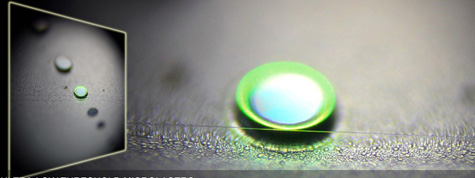
Image by J. Zhu, L. He, S. K. Ozdemir, and L. Yang/WUSTL
Whispering-gallery microlasers can count and measure nano-scale synthetic or biological particles. As this conceptual illustration shows, a particle disturbs the lasing “mode” to split into two frequencies (shown here as two different colors) and the frequency split acts a ruler that allows the particle to be measured. The inset at the top right shows a particle landing on the microlaser (a torus supported by a pedestal). Lina He, a graduate student in electrical and systems engineering at Washington University in St. Louis, and her co-workers demonstrated that the microlasers can detect particles 10 nanometers in radius. Their resolution limit is about one nanometer.
A tiny doughnut-shaped laser is the latest marvel of silicon microminiaturization, but instead of manipulating bits it detects very small particles. Small particles play a big — and largely unnoticed — role in our everyday lives. Virus particles make us sick, salt particles trigger cloud formation, and soot particles sift deep into our lungs and make it harder to breathe.
The sensor belongs to a category called whispering gallery resonators, which work like the famous whispering gallery in St. Paul’s Cathedral in London, where someone on the one side of the dome can hear a message spoken to the wall by someone on the other side. Unlike the dome, which has resonances or sweet spots in the audible range, the sensor resonates at light frequencies.
Light traveling round the micro-laser is disturbed by a particle that lands on the ring, changing the light’s frequency. The ring can count the touch-down of as many as 800 nanoparticles before the signals begin to be lost in the noise. By exciting more than one mode in the ring, scientists can double-check the accuracy of the count. And by changing the “gain medium,” they can adapt the sensor for water rather than air.
Lan Yang, PhD, assistant professor of electrical and systems engineering at Washington University in St. Louis who leads the team that fabricated the new sensor, says that there is already lively interest in its commercialization in fields ranging from biology to aerosol science. The sensor is described and characterized in the June 26 online edition of Nature Nanotechnology.
Whispering gallery resonator becomes microlaser

In the days of prop planes, air travelers were very familiar with beat frequencies. If the propellers of a plane are rotating at slightly different speeds they produce a wubba-wubba sound that is a beat frequency.
To listen to a beat frequency (not from a plane) click here:
A whispering gallery resonator supports “frequency degenerate modes” (modes, or patterns of excitation in the ring, with the same frequency, one traveling clockwise and the other counterclockwise around the ring.
The mode fields have “evanescent tails” that penetrate the surface of the ring and probe the surrounding medium. When a particle lands on one of the “hot spots” it scatters energy from one of the modes into the other, and the modes adopt slightly different resonance frequencies. This is referred to as mode splitting.
In an earlier work, Yang team used mode splitting in a simple glass ring that functioned as a waveguide for light coupled into it from outside. Because the ring was passive, the external-laser had to be an expensive tunable laser so that it could scan a frequency range looking for the ring’s resonances to measure mode splitting. (For more information on this sensor see “Tiny sensor takes measure of nanoparticles.”)
The new sensor differs from earlier whispering gallery resonators in that it is itself a miniature laser rather than the resonating cavity of an external laser.
The new sensor is also glass but glass laced with atoms of the rare earth elements that serve as a “gain medium.” The glass is doped with rare-earth atoms and when an external light source boosts enough of them into an excited state, the ring begins to lase at its own preferred frequency.
When a particle lands on the microlaser, a single lasing line splits into two slightly different frequencies.
A simple way of measuring the frequency splitting is to mix the split laser modes in a photodetector, which produces a “beat frequency” that corresponds to the frequency difference.
“The tiny sensors are mass produced by sol-gel method on silicon wafer, and it is easy to switch the gain medium” says Lina He, a graduate student and first author of the paper. “The resonators are made by mixing the rare-earth ions of choice into a solution of tetraethoxysilane, water and hydrochloric acid. The solution is heated until it becomes viscous and then spin-coated on a silicon wafer and annealed to remove solvents and complete the transition to amorphous glass. The thin film of glass is then etched to create silica disks supported underneath by silicon pillars. As a final step, the rough silica disks are reflowed into smooth toroids by laser annealing.”

Image by J. Zhu, L. He, S.K. Ozdemir, and L. Yang/ WUSTL
Arrays of microlasers (left) are carved from sol-gel silica films on silicon wafers by photolithography, etching and reflowing steps. When light is coupled into a microlaser through a whisker-thin optical fiber (right) rare-earth atoms (in this case erbium), excited by the pump light, begin to fluoresce (right). Because some of the light penetrates the glass, the laser modes are perturbed by particles that land on the ring.
Active sensor outperforms passive one
“The light used for sensing is generated inside the resonator itself, and so it is purer than the light in the passive sensor,” says Yang “When the light is not that pure, you might not be able to see small frequency changes. But the active sensor hits one frequency — it has a really narrow linewidth — and so it is much more sensitive.”
The microlaser is orders of magnitude more sensitive than the passive resonator, she says. Its effective resolution limit is about one nanometer. One nanometer is to a meter, what a marble is to the Earth.
Moreover, because the laser is now in the ring rather than coupled to it, the entire system is simpler and more self contained. “Now you just need a light source to excite the optical medium,” says Yang, “and you can use a cheap laser diode for that instead of an expensive tunable laser.”
Detecting many particles
The effect of a particle on a lasing mode depends on the particle’s “polarizability,” which is a function of its size and refractive index. To cover the possibilities, the Washington University team tested the micro-laser’s performance with nanoparticles of various sizes made of various materials, including polystyrene (packing peanuts), virions (virus particles) and gold.
As particles enter the “mode volume” of the micro-laser one by one, the scientists can see a discrete upward or downward jump in the beat frequency. Each discrete jump signals the binding of a particle on the ring, and the number of the jumps reflects the number of particles.
Because the “resonator field” traps the particles on the resonator, once landed, they rarely drop off. But the team found they were able to count many particles before the losses induced by the particles made the laser linewidths so broad they couldn’t detect changes in frequency splitting due to the latest arrival.
For example, they were able to detect and count as many as 816 gold nanoparticles using the same laser mode.
“When the line broadening is comparable to the change in splitting, then you’re done,” says Yang. “However, the whole resonator is fabricated on the chip, so you could just move on to the next resonator if necessary.”
Doubling up for accuracy
The micro-laser can support more than one laser mode at a time. “By controlling the overlap of the pump light with the gain medium, you can excite more than one laser line,” says Sahin Kaya Ozdemir, PhD, a research associate and co-author. “Then when a particle lands on the ring, each laser line will split into two, and generate a beat frequency. So you will have two beat frequencies instead of one.”
That’s an advantage, he explains, because the beat frequency depends in part on where the particle lands on the ring. If there is only one laser line and the particle falls between “hot spots” it might not be detected. The second beat frequency prevents these “false negatives,” ensuring that every particle produces a detectable beat frequency.
Detecting particles in water
The microlasers intended to sense particles in air had been doped with erbium, a rare-earth element whose optical properties are well matched with those of air. In a final experiment designed to see whether this technique could be used to sense particles in water or blood, the team fabricated sensors that were doped with ytterbium rather than erbium. Ytterbium lases at wavelengths with low absorption by water.
Yang’s team has already begun working to make use of the enhanced sensitivity provided by the microlaser for studying various problems. In terms of applications, “the near-term use will be the monitoring of dynamic behaviors of particles in response to environmental and chemical changes at single particle resolution,” says Yang.
The next step, the team see is to engineer the surface of these tiny microlasers to detect DNA and individual biological molecules. If the DNA is tagged with engineered nanoparticles, the micro-laser sensor can count individual DNA molecules or fragments of molecules.
Listening to Yang it is hard to escape the impression that you’re hearing for the first time about an astonishing device that will one day be as ubiquitous — and probably as underappreciated — as the logic gates in our microwaves, cellphones and cars.
The Washington University in St. Louis team behind these results includes: L. He, W. Kim and J. Zhu, graduate students; S. K. Ozdemir, PhD, a research associate, and L. Yang, PhD, assistant professor in electrical and systems engineering.
This work is supported by National Science Foundation.
Lina He, Sahin Kaya Ozdemir, Jiangang Zhu, Woosung Kim and Lan Yang, “Detecting single viruses and nanoparticles using whispering gallery microlasers,” Nature Nanotechnology, advanced online edition, June. 26, 2011. DOI: 10.1038/NNANO.2011.99